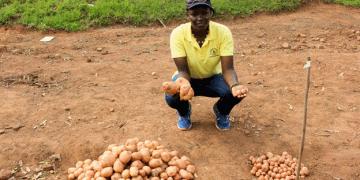Ongoing research at Michigan State University (MSU) could have a major impact on the way leafy greens are processed in the United States.
That’s according to a report Elliot Ryser gave to the Michigan Vegetable Council in March. Ryser is a professor at MSU’s Department of Food Science and Human Nutrition. He and his colleagues are working on a systems approach to minimize the E. coli O157:H7 hazards associated with fresh and fresh-cut leafy greens.
According to the report, the research has four main objectives: 1) To assess the quantitative transfer of E. coli between leafy greens during processing operations. 2) To assess the efficacy of intervention strategies for enhancing the safety and shelf life of fresh-cut leafy greens contaminated with E. coli. 3) To develop a mathematical risk model for E. coli contamination associated with the production and sale of leafy greens. 4) To disseminate research outcomes and potential management strategies through committee and regional stakeholder meetings.
The research’s target audience includes leafy green growers, processors, retailers, equipment suppliers, government regulators and industry associations, according to the report.
To satisfy the first objective, the researchers inoculated leafy greens with E. coli and ran them through a simulated processing line, in an attempt to discover the amount of E. coli that would transfer to the equipment during processing.
The researchers found that, during leafy green processing, 83 percent to 97 percent of the E. coli inoculum transferred to the wash water. After processing, E. coli populations were highest on the shredder and conveyor, followed by the flume tank and shaker table, according to the report.
“It’s very hard to get rid of E. coli once it gets in the processing line,” Ryser said.
The researchers also looked at the transfer of E. coli from processing equipment to product. It’s quite clear that the bacteria can persist on equipment during processing, and subsequently contaminate large quantities of previously uncontaminated fresh-cut leafy greens, according to the report.
To meet the second objective, the researchers are looking at the effect X-ray radiation has on E. coli. According to the report, FDA published a rule last year that allows the use of irradiation for pasteurizing iceberg lettuce and spinach. The new rule gives the industry an opportunity to adopt irradiation technologies that can inactivate E. coli without adversely affecting quality characteristics.
The researchers have been working with Rayfresh Foods – an Ann Arbor, Mich.-based company – on the X-ray studies, Ryser said.
The research is far from over, but, according to the report, “X-ray irradiation has several key advantages, including greater efficacy against bacterial foodborne pathogens without adversely impacting product quality and the ability to be easily installed in commercial facilities for continuous in-line processing.”
For the third objective, a probabilistic model was constructed in Excel to account for E. coli cross contamination when contaminated lettuce enters the processing line, according to the report. Results obtained from the model “suggest that most sampling plans will not effectively detect E. coli O157:H7 during production. Hence, in the absence of an E. coli kill step, diligent application of sanitizers to the equipment and wash water is recommended to reduce cross contamination during processing.”
And finally, to satisfy the fourth objective, preliminary research data were shared at a steering committee meeting last August in Columbus, Ohio, in conjunction with the annual meeting of the International Association for Food Protection. Data also were shared at the Michigan Vegetable Council meeting in March.





